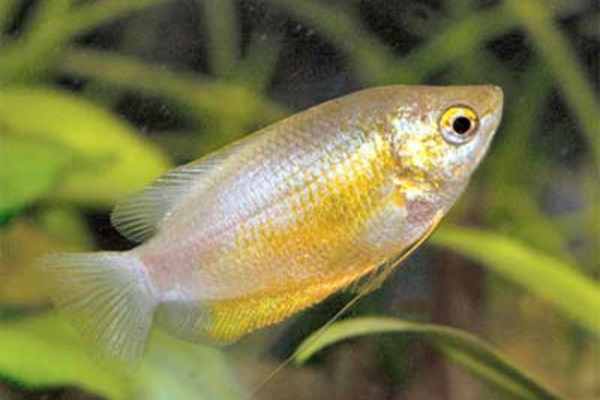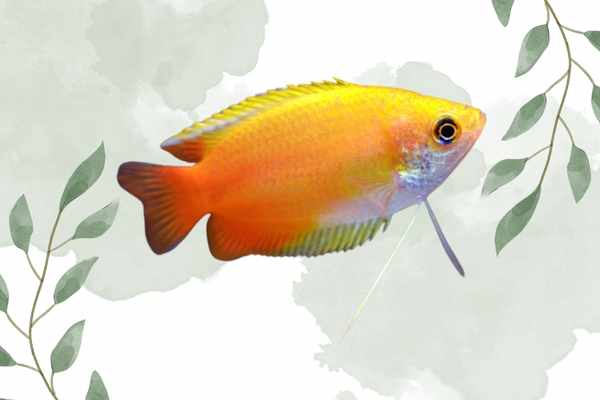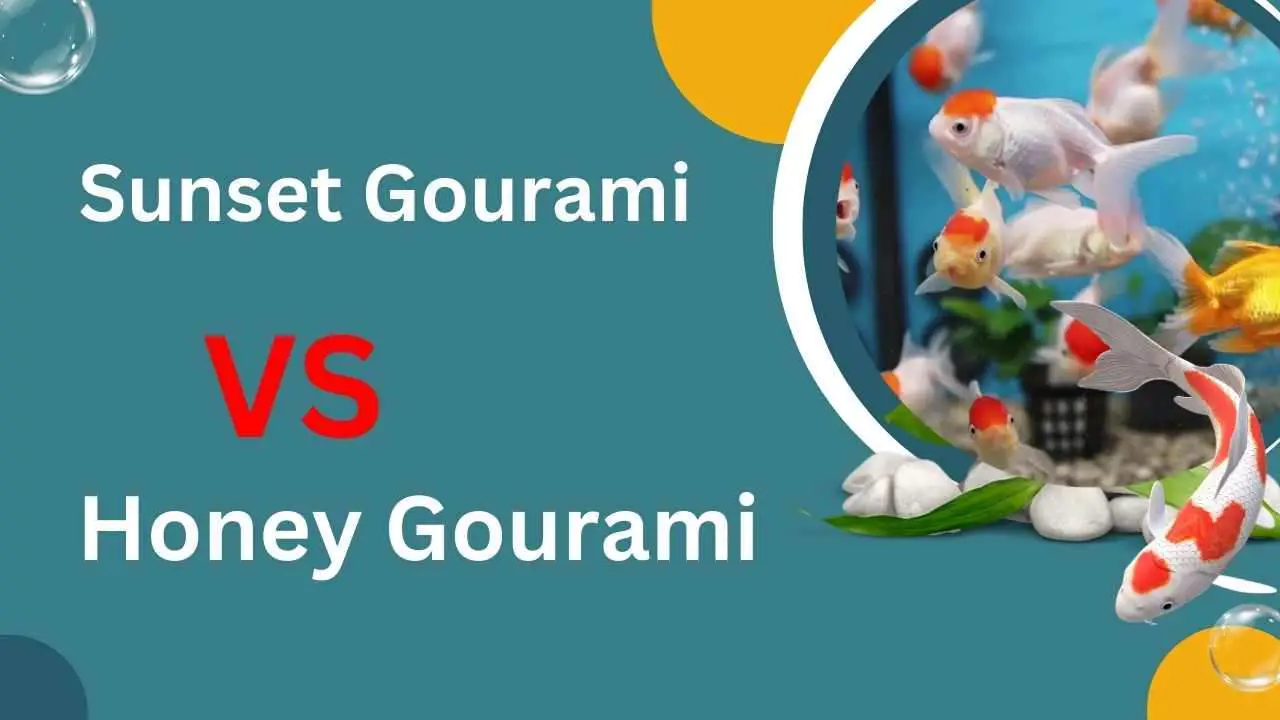The Sunset Gourami and Honey Gourami are two species of freshwater fish commonly kept in aquariums. Both species belong to the family Osphronemidae and are native to Southeast Asia. Sunset Gourami is also known as Sunset Honey Gouram which is known for their striking orange color, while Honey Gouramis are known for their light yellow color. Both species are popular among aquarium hobbyists due to their peaceful nature, attractive appearance, and easy-to-care-for. In this comparison, we will take a closer look at the physical characteristics, temperament and behavior, care requirements, and health considerations of Sunset and Honey Gouramis to help you make an informed decision when choosing the right species for your aquarium.
Systematic Position
Phylum: Chordata
Subphylum: Vertebrata
Class: Actinopterygii
Order: Perciformes
Family: Osphronemidae
Genus: Trichogaster
Species: Trichogaster labiosa (Sunset Honey Gourami)
Trichogaster chuna (Honey Gourami)
Distribution and Habitat
The Sunset Gourami (Trichogaster labiosa) and Honey Gourami (Trichogaster chuna) are native to Southeast Asia, specifically in the countries of Bangladesh, India, Thailand, Malaysia, and Indonesia. They can be found in slow-moving or stagnant bodies of water, such as rice paddies, swamps, and streams. In their natural habitat, these fish prefer areas with vegetation and a soft substrate.
Physical Characteristics
Both Sunset Gourami and Honey Gourami have a labyrinth organ, which allows them to gulp air from the surface and extract oxygen from it, enabling them to survive in low-oxygen environments. This characteristic also gives them the ability to breathe air, making them highly adaptable to different aquarium environments.
Some key physical characteristics of Sunset Gourami and Honey Gourami are as follows:
Sunset Gourami
Body Shape: Sunset Gouramis have a tall and laterally compressed body with a long, flowing dorsal and anal fin.
Color: They have a distinctive reddish-orange color that becomes more vibrant and brighter as they age.
Size: Sunset Gouramis can grow up to 4 inches in length.

Honey Gourami
Body Shape: Honey Gouramis have a rounded, compact body with a short, rounded dorsal and anal fin.
Color: They have a light yellow color that is uniform across their body.
Size: Honey Gouramis are much smaller than Sunset Gouramis, reaching a maximum size of 2.5 inches.

Quick Stats
Here are quick stats for Sunset Gourami and Honey Gourami:
Sunset Gourami
• Size: up to 5 inches
• Color: reddish-orange
• Temperament: peaceful
• Tank Size: minimum 30 gallons
• Water pH: 6.5-7.5
• Temperature: 76-82°F
Honey Gourami
• Size: up to 2.5 inches
• Color: light yellow
• Temperament: peaceful
• Tank Size: minimum 20 gallons
• Water pH: 6.5-7.5
• Temperature: 76-82°F
Feeding
Both Sunset Gouramis and Honey Gouramis are omnivores and will feed on both plants and small invertebrates in their natural habitat. In an aquarium setting, they will accept a variety of food options, including:
Pellets or flakes: A high-quality, balanced diet of pellets or flakes will provide them with all the necessary nutrients.
Live or frozen foods: Live or frozen foods such as bloodworms, brine shrimp, or daphnia will provide them with additional variety and nutrition.
Vegetables: Vegetables such as spinach, peas, or lettuce can be offered as a supplement to their diet.
You should offer a varied diet to ensure fish receive all the nutrients for good health. Overfeeding should be avoided, as it can lead to water quality issues and health problems. Feed them small portions two to three times per day, and avoid feeding them more than they can eat in a few minutes.
Temperament and Behavior
Sunset Gouramis and Honey Gouramis are generally peaceful and well-behaved fish that are well-suited for community aquariums. They are known for their social and timid behavior, and they will spend much of their time swimming near the surface or hiding among vegetation.
Both species are also known for their fascinating mating behavior, in which the male builds a bubblenest at the surface and courts the female by displaying his vibrant colors. If the female is receptive, she will lay her eggs in the nest, and the male will fertilize them and guard the nest until the eggs hatch.
You should provide plenty of hiding places, such as live or artificial plants, to help your Gouramis feel secure in their environment. Providing them with adequate space and a peaceful community of compatible tank mates will also contribute to their overall health and well-being.
Overall, Sunset and Honey Gouramis are attractive, peaceful, and easy-to-care-for fish that make great additions to any community aquarium.
Care and Maintenance
Here are some tips for caring and maintaining Sunset Gouramis and Honey Gouramis:
Tank Size: Sunset Gouramis need a minimum tank size of 30 gallons, while Honey Gouramis can be kept in a minimum tank size of 20 gallons.
Water Conditions: They prefer warm, clean water with a pH of 6.5-7.5 and a temperature range of 76-82°F. It is important to regularly check and maintain the water parameters in your tank to ensure the health of your Gouramis.
Filtration: A good filtration system is essential to maintain the water quality in your tank.
Lighting: Provide low to moderate lighting in your tank to mimic their natural environment.
Substrate: A soft, fine substrate is recommended for your tank, as the Gouramis like to forage and dig in the substrate.
Tank Mates: Sunset and Honey Gouramis are peaceful fish and are well-suited for community aquariums. Choose compatible tank mates, such as other peaceful fish, to create a harmonious community.
Breeding Behavior
Sunset and Honey Gouramis are relatively easy to breed in an aquarium setting. Here are some tips for breeding these fish:
Tank Size: A breeding tank should be at least 20 gallons for Honey Gouramis, and 30 gallons for Sunset Gouramis, with plenty of hiding places and a low water level to allow for the construction of a bubblenest.
Water Conditions: Maintain the water parameters in the breeding tank as close to their natural habitat as possible, with a pH of 6.5-7.5, a temperature range of 76-82°F, and soft, slightly acidic water.
Conditioning the Fish: Condition the breeding pair by feeding them a varied diet of live or frozen foods, and gradually increase the temperature in the breeding tank to simulate the onset of the breeding season.
Bubblenest: The male will construct a bubblenest at the surface, and courtship and mating will occur beneath the nest.
Fertilization: If the female is receptive, she will lay her eggs in the nest, and the male will fertilize them. The male will guard the nest until the eggs hatch, usually within 24-48 hours.
Fry: The fry will emerge from the nest and will initially feed on their egg sacs before being fed newly hatched brine shrimp or other small live foods.
Diseases and Treatment
Sunset and Honey Gouramis, like all fish, are susceptible to various diseases. Here are some common diseases and treatments:
Ich: Ich is a parasite that causes white spots on the skin and fins of fish. It is treated with an ich medication, such as a copper-based treatment or an aquarium salt treatment.
Fin Rot: Fin rot is a bacterial infection that causes the fins to become frayed and damaged. It is treated with an antibiotic treatment, such as a kanamycin-based medication.
Swim Bladder Disorder: Swim bladder disorder is a condition that affects the swim bladder and causes the fish to float upside down or struggle to swim. It is treated by fasting the fish for a period of time and feeding a diet of high-quality, easily digestible foods.
Columnaris: Columnaris is a bacterial infection that causes sores and ulcers on the skin and fins of fish. It is treated with an antibiotic treatment, such as a nitrofurazone-based medication.
You should regularly check the health of your Gouramis and to take action if you notice any signs of disease. Early treatment is key to preventing the spread of disease and promoting the health and well-being of your fish. Additionally, maintaining proper water parameters and providing a healthy diet and environment will help to prevent disease and keep your Gouramis healthy.
Which Species Is Better Choice for Aquarium?
The best choice of fish for an aquarium will depend on your personal preferences and the size and composition of your aquarium. Both Sunset and Honey Gouramis are attractive and fascinating fish that can add a pop of color and personality to any aquarium.
Price Range
The price range for Sunset and Honey Gouramis can vary depending on the size, location, and availability of the fish. On average, you can expect to pay between $3 to $10 for a small juvenile Sunset or Honey Gourami, and up to $20 or more for a larger adult specimen. It’s also important to note that prices can fluctuate based on demand and availability, so it’s always a good idea to check with local fish stores or online retailers for the most up-to-date prices.
Frequently Asked Questions
Question-1: Can Sunset and Honey Gouramis be kept together in the same aquarium?
Answer: Yes, both Sunset and Honey Gouramis are peaceful and docile fish that can be kept together in the same aquarium as long as there is enough space and hiding places provided.
Question-2: Do Sunset and Honey Gouramis need a heater in their aquarium?
Answer: Yes, it’s important to maintain a consistent water temperature for Sunset and Honey Gouramis, so a heater is recommended.
Question-3: Can Sunset and Honey Gouramis be bred in an aquarium?
Answer: Yes, Sunset and Honey Gouramis can be bred in an aquarium, although it can be challenging. Providing proper water conditions, a suitable breeding setup, and a varied diet can increase the chances of success.
Concluding Remarks
In conclusion, Sunset and Honey Gouramis are both attractive and peaceful fish that can make great additions to any aquarium. The Sunset Gourami is known for its striking orange and red coloration, while the Honey Gourami has a more subdued golden-yellow coloration. With proper care and maintenance, Sunset and Honey Gouramis can be healthy and long-lived additions to any aquarium community.


